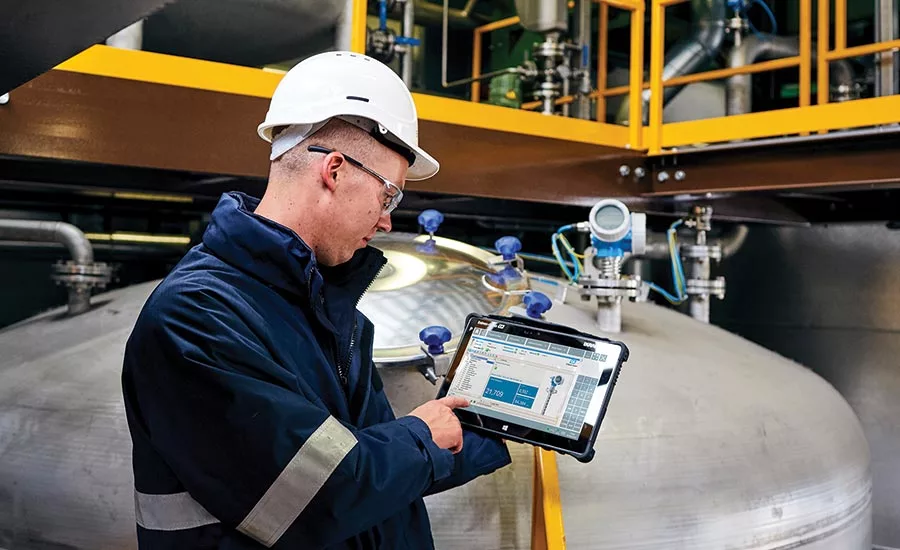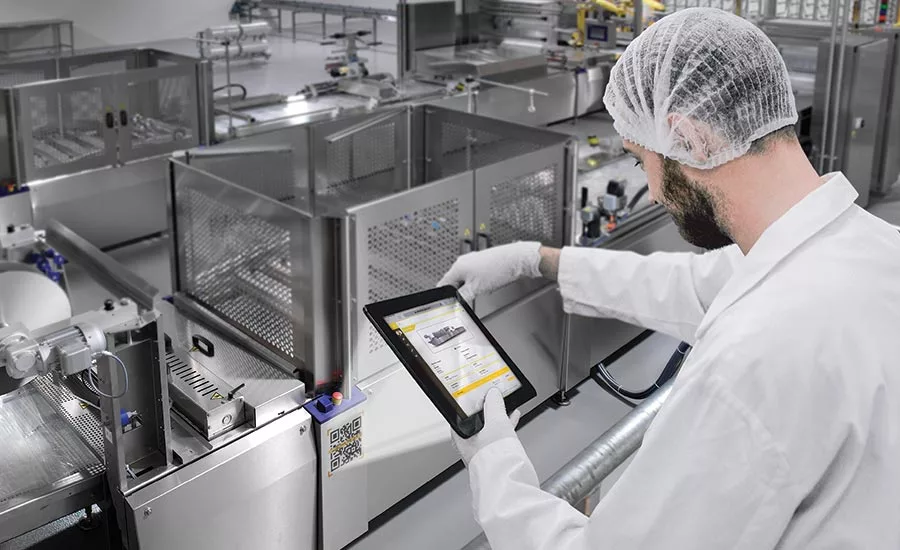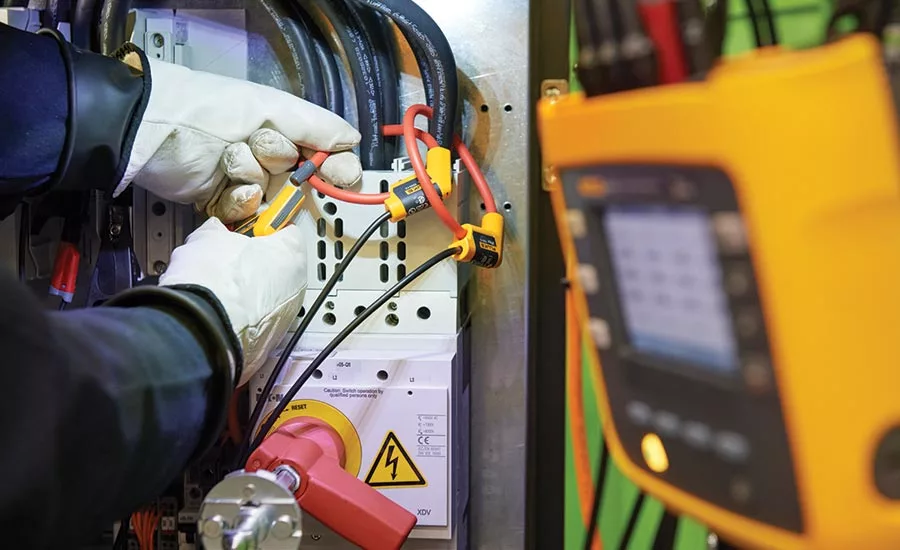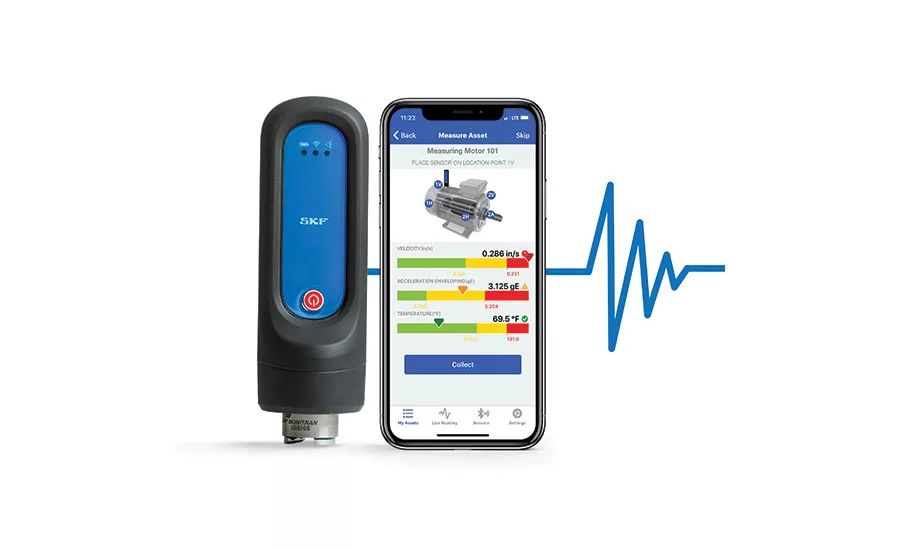Automation Series
How food processors can use IIOT for maintenance activities

The Field Xpert SMT70 tablet PC enables mobile plant asset management in hazardous and nonhazardous areas, and allows the maintenance staff to manage field instruments via a digital communication interface.
Photo courtesy of Endress + Hauser

GEA has opened a new cloud-based platform for digital services, which will include tools for maintenance activities. First available in Germany, the site will soon become available for most common languages.
Photo courtesy of GEA

Swift Sensors, developer of IIoT wireless systems, has created PdM tools for its Manufacturing Analytics Dashboard, adding trend analytics to key manufacturing metrics of compliance, utilization, and min and max average measured values—totaling 11 new dashboard panels.
Photo courtesy of Swift Sensors

Food and beverage workers need to know the status and condition of assets. Using connected condition devices helps teams view information from critical assets in order to make data-backed decisions about scheduling and maintenance planning.
Photo courtesy of Fluke

SKF has launched SKF Pulse, which combines an easy-to-use, hand-held sensor with a new mobile app, allowing users to quickly monitor rotating equipment and machine health to predict issues and improve reliability before operations are adversely affected.
Photo courtesy of SKF
Food Engineering’s recent Food Automation & Manufacturing Conference addressed several high-tech Industry 4.0 topics, including OEE, IIoT, predictive maintenance (PdM), artificial intelligence (AI) and equipment self-diagnosis, and automated parts ordering. One of our speakers jested that since there were no dedicated cybersecurity talks on this year’s schedule, we must have figured out how to do cybersecurity.
So, I’m not going to hammer you with IIoT cybersecurity warnings and prognostications in this article. I did enough of that in February with “Cybersecurity helps manufacturers create more secure, resilient networks.” Rather, I’d like to show how you can use IIoT tools to improve your maintenance program—to move beyond preventive maintenance (PM) activities to PdM—and maybe even better your OEE scores in the process.
Article Index:
Even if you haven’t thought much about IIoT-connected PdM, sensor and automation suppliers have been assuming an active role in making sure their devices and equipment can not only provide the sensor or machine data you need for your process, but also data streams for sensor or machine health—which you can apply in a PdM environment. Often, these suppliers provide the device health data for free, or you can take advantage of paid services to continuously monitor machine/device health data to predict when you need to change a wearing part, provide lubrication or do some other maintenance activity before you have a catastrophic failure, shutting down your line or plant.
Not only do sensor and machine builders supply the tools you need to monitor device/machine health, but there are plenty of third-party CMMS (computer-based maintenance management systems) software suppliers and other AI-based asset management systems available that allow you to move your PM program to a PdM environment. We’ll look at some of the options.
Port services to portals
There was a time when an automation supplier provided a “portal” to its machine for troubleshooting purposes through a dial-up modem, which was limited in data throughput. Today, you can have a persistent LAN connection of 100 Mbits/s or faster that can connect back to the supplier via the internet through a VPN (virtual private network).
IIoT-based technology certainly encompasses far more than troubleshooting a single machine. For example, GEA has announced a cloud-based, supplier-independent portal to provide customers modern service solutions, such as remote maintenance, data analysis and comprehensive e-commerce. The portal enables them to integrate seamlessly all their supplier interactions in one common platform. The platform includes spare parts ordering, technical documentation, and training manuals and services.
“Digitalization has a customer-facing and internal company-related perspective,” says Kerstin Altenseuer, GEA head of service development. “To develop our service excellence in both directions, we started the Advance initiative for GEA Service, which serves as an umbrella for all the new digital solutions we offer to our customers. The digital cooperation project enables us not only to create a new customer portal, but especially to understand the customers’ processes and optimize the collaboration by means of digital infrastructures.”
Having recently purchased CMMS companies, Fluke, an instrumentation and test equipment manufacturer, now offers an array of products and services aimed at keeping manufacturing systems up and running. A great way to get started is by taking advantage of the Accelix Connected Reliability Assessment program offered by Fluke, says Greg Perry, senior capacity assurance consultant. “Our experts will visit a plant, interview key stakeholders and catalog the plant’s readiness for an asset condition management (ACM) journey.” The results identify potential quick wins and challenges to overcome. Fluke has an array of ACM solutions for assets commonly used in food and beverage plants, including vibration and power sensors. Some products come with associated software for trending and machine monitoring.
With digitalization, instrument suppliers can keep tabs on installed equipment, sometimes better than their users. “Many times we start with an installed base analysis (IBA) of instrumentation, where we locate and document every instrument in the plant and enter the data into a life cycle management portal,” says Ola Wesstrom, Endress+Hauser USA senior industry manager, food and beverage. This enables a clear analysis of criticality versus risk of maintainability, which then can be used to define maintenance requirements and possible migration needs.
“We have found that many plants’ record of their installed base is very lacking, with maintenance points often massively underestimated,” adds Wesstrom. “To support the IBA, we use handheld tablets to collect and categorize instruments. From here we provide a comprehensive report, along with follow-up services, such as calibrations or set-up enhancements.”
Digitalization fosters collaboration
Digitalization can actually promote collaboration. “We offer a cloud-based digital service focused on thermal processing, supported by decades of drying algorithms,” says Dorian Kusznir, Bühler Group engineering manager, digital services. “It is designed to create a digital relationship between us and our customers. Our service is a culmination of traditional customer services with data analytics, which is key to helping people begin to communicate with data systems.”
A digital relationship adds value to a single point-in-time contact. When manufacturers work with vendors and machine manufacturers, they do it in a linear way, says Kusznir. To get the most out of a drying equipment purchase, manufacturers in the process industries need access to drying process expertise. They can get this by coming to drying seminars, requesting site visits and field engineering evaluations, or simply by calling. But these interactions, based on single point-in-time interactions, flow in one direction. This is a lone business model, where the processor is requesting support. The provider does not have access to processor data because it is generally stored in silos.
The new frontier is a model of collaboration. A processor can be constantly connected to a solution provider’s expertise, says Kusznir. Processors already have the sensors in place, collecting data. Cloud-based management, or the digital relationship, can enable a back-and-forth flow of information analytics between the processor and the provider. Both can see a dashboard that centralizes and synthesizes data in real time for meaningful insights. IIoT data management interconnects information to help Bühler customers realize new business models, optimize internal processes and achieve major cost savings. It allows customers to take advantage of process knowledge full time and make it sustainable.
“As a control system integrator, we provide a variety of software tools to capture valuable plant floor data and deliver it in a meaningful way to the entire enterprise, including the maintenance department,” says Michael McEnery, president, McEnery Automation, a Control System Integrators Association Certified Member. “This includes systems that assist with identifying failures that have already occurred, such as OEE systems, as well as preventing failures that have not yet occurred through preventive and predictive maintenance.”
OEE systems identify the root causes of downtime events and provide insight, such as how to prioritize resolving equipment failures. Typically, the insights are applied to packaging lines, but food plants can also use them for process areas and units.
Predictive maintenance systems can provide warnings for motors running at high current or high temperature, says McEnery. Packaging equipment in food plants increasingly uses servos in place of pneumatic systems. Being able to monitor these motors and replace them before they fail is very beneficial. Capturing data related to flow valves, including the torque and time required to operate, can predict an imminent failure.
Batch reports that compare time in step between batches can identify process equipment that is underperforming and may require maintenance, including problems like reduced pump flow, dirty filters, clogged heat exchangers or flow valves not opening fully, says McEnery.
In the warehouse, IIoT technologies help users maintain their lift trucks, which are wirelessly connected to the cloud. “Our Yale Vision wireless asset management system delivers real- time telemetry data on every piece of equipment in a customer’s fleet,” says Kevin Paramore, Yale Materials Handling Corp. sales and marketing manager. The cloud-based system allows end users to access reports and receive notifications via any device with an internet connection. These capabilities can be put to use to optimize fleet size, structure and maintenance.
With the ability to evaluate utilization and maintenance information alongside expected demand and specific truck applications, fleet managers can make quick and informed decisions about fleet size and composition. In this way, operations can right-size fleets and eliminate the cost of running excess trucks, says Paramore.
Another important feature that is exclusive to telemetry systems from an OEM, like Yale Vision, is fault code monitoring. This triggers an automatic alert that instructs dealers to perform proactive service. This can help prevent minor issues, such as low hydraulic pressure or slight controller damage, from escalating into more serious problems that can result in crippling downtime and costly repairs. Fault code monitoring also helps service providers improve first-pass completion by predetermining the parts necessary to address the issue.
Third-party maintenance solutions
Third-party maintenance solutions range from asset management, project management, PM, PdM to OEE and other metrics. AVEVA offers asset performance management consulting services and risk-based maintenance software to help food and beverage plants understand the role, contribution to the business and criticality of each asset in the plant, says Matt Newton, senior portfolio marketing manager, APM. With that information the leadership team can balance risk, cost and performance to develop a flexible maintenance strategy that aligns with corporate objectives and scales with the business.
“We recently delivered consulting services to a global food and beverage manufacturer that resulted in a $250,000 per site per year savings, in addition to a 15% increase in workforce efficiency and 15% increase in workforce effectiveness,” says Newton. “We also enable food and beverage plants to collect and analyze instrumented and non-instrumented asset data to identify new insights that drive more efficient operations.”
AVEVA’s condition-based and preventative maintenance management solutions allow manufacturers to achieve routinely a 30% reduction in maintenance costs and to reduce downtime up to 95%, says Newton.
While machine builders will offer machine monitoring and PdM as a service, the same is often true for automation suppliers. “Predictive maintenance as a service is one of our newer maintenance resources, which combines software and services to help prevent failures and unplanned downtime,” says Phil Bush, Rockwell Automation product manager, managed services—infrastructure. Simultaneously, with analytic intelligence, it also enables reduced maintenance cost per unit produced. The service helps food and beverage producers avoid maintenance issues by giving customers the ability to monitor predictions and analyze details without having to build their own models or solutions.
Dude Solutions provides a CMMS tool that can be used to improve overall operations and profitability, says Paul Lachance, senior manufacturing advisor. “CMMS is often viewed as a critical end point of IIoT data. Your asset isn’t performing well? An IIoT-enabled CMMS environment will have a work order created in the quickest possible time, requisitioning the best staff/contractor to do the work with automatic notification.” A CMMS should be able to cover the gamut of assets (IIoT enabled or not), work with multiple departments and be accessible from desktop systems or mobile devices. It’s not just about software; services to listen to goals/needs/pain points to ensure effective solutions are critical, says Lachance.
Eagle Technology, according to Harshad Shah, CEO and president, develops and provides EAM and CMMS software for either SaaS (cloud) or on-premise use. Eagle also offers consulting and project management services for proper system implementation. Eagle partners with IIoT and analytics companies (such as Rockwell, Siemens and PTC) for the integration of IT and OT.
Suhas Hajgude, IoT product management director at MHS, says the company “has a combination of IIoT technology capabilities and industry expertise that deliver targeted, data-driven insights that solve real problems facing food and beverage plants—helping boost labor efficiency, limit unplanned downtime and address safety challenges. Rather than monitoring every individual asset, MHS focuses on the most critical and failure-prone assets to provide the most value in the most efficient framework.
“We offer an integrated solution that uses software to tie a number of different hardware components and data sources together,” says Hajgude. “We combine them and use machine learning and domain expertise to advise food and beverage plants of the assets that have a high likelihood of failure.”
Digital twin: Concept or reality
“Digital twin” is a term that came out of the aviation industry for monitoring the life cycle of jet engines; the engine is modeled in software, and its performance is tracked (often in real time) as the engine ages. Siemens Industry has applied the same technology in the food and beverage industry in three components, according to Eric Kaczor, F&B marketing manager. First, a digital twin is created of a food product and its packaging; second, for production monitoring; and third, for performance analysis.
While the digital twin concept can be used to create new business opportunities, improve production models and analyze operational data, the concept can also be used to improve production system efficiency. Improving production efficiency can be directly tied to maintenance, says Kaczor. By collecting operational data from sensors, SCADA systems, PLCs or other devices connected via IIoT and analyzing the information in the cloud or edge computing devices, it’s possible to predict disruptions before they happen. AI and machine learning can be applied to detect anomalies on production equipment, allowing maintenance to get a leg up on equipment beginning to fail.
Leveraging the digital twin, technologies in AVEVA enable processors to bridge operations, engineering and information technology to create a single source of truth across the entire asset life cycle, enabling better access to information throughout the organization, says Newton. Data accumulated in the cloud can be analyzed using predictive analytics, which provide remote monitoring and diagnostics within the plant without having to write any software. Condition-based, predictive and prescriptive capabilities provide flexibility in data analysis and enable a shift from reactive to prescriptive maintenance.
Too much data, siloed data
Lots of machines and automation hardware collect data through various sensors, and it would seem the more data, the better. “We like to use equipment reliability data to identify opportunities to implement these technologies to solve problems,” says Mark Hungerford, Leading2Lean VP customer support.
The problem is that if everything is connected, there is so much data that it becomes noise. You’ll end up spending hours or even days sifting through the data just to find the nugget of insight that tells you what to focus on, says Hungerford. IIoT sensors and their data should be a tool to help identify problems earlier; they’re not the solution to the problems.
Most food processors already have lots of data, but it’s siloed, says Bühler’s Kusznir. A cloud-based system in conjunction with process partners is key to creating operational transparency. With IIoT management, it is possible to marry one chart with another and analyze the data to gain insights that were not possible before. Simply put, IIoT makes data relevant.
Comparing data can reveal changes over time in recipes and operating parameters. In one instance, a processor was able to determine that excessive dryer usage wasn’t a maintenance problem, but actually an operational issue, he says. A correction reduced energized time of the dryer and saved energy in the process.
Fluke describes an “operations-maintenance gap,” whereby data streams from SCADA, PLC and other operating systems are not integrated with maintenance software or readily available to teams. Fluke’s Accelix Connected Reliability Framework, according to Perry, was designed to aggregate industrial, condition-based actionable data and provide it to widely used EAM systems, capturing a more complete picture of asset health.
“In our estimation, there are not many products that break the silos between operational data, maintenance records and internal machine data while also introducing additional independent sources of sensor technologies,” says MHS’s Hajgude. MHS Insights was developed to connect to the company’s EAM system. “Our EAM allows us to ingest data about specific assets, while our connected sensors allow us to generate real-time data about the machine state. Bringing this in with the ability to create and track historical work orders gives us a rich picture of the overall maintenance landscape for a particular plant,” says Hajgude.
“Given our belief in an agnostic approach that does not force specific hardware, software, etc., our suggestion is that clients use an ‘IIoT data layer’ where any/all data end up regardless of source, protocol, etc.,” says Dude Solutions’ Lachance. A CMMS can work with data from any normal data source, but it is advantageous for manufacturers to have a data layer where any /all IIoT data can end up, simplifying the integration and analysis of data.
However, not all data available from an equipment-specific or edge-based system needs to be moved into a plant-wide historian, says McEnery. It’s best to identify the key data points that may be useful in showing relationships with other plant processes and move only those to the historian. Determine what operational parameters might cause an effect on upstream or downstream equipment and vice versa, and bring those into the plant historian so that analytics can be used to single out root causes of performance issues that might not be obvious.
“Two things to be very mindful about: relevance and actionable information,” says Endress+Hauser’s Wesstrom. It is easy to get carried away and start pulling data, but if it is not relevant to those it is intended for or actionable, then it becomes a distraction from critical information. Need and impact must be examined for each operational function to determine if the information is important and what would be done with it. Specific wear and tear info would, for example, be used for preventive maintenance, and a functional verification tool could be used to extend maintenance intervals.
Some final thoughts on IIoT, AI and maintenance
“IIoT, of course, is a lot broader than just connecting sensors into maintenance or operational platforms,” says Keith Chambers, AVEVA vice president, operations management software. It is also an enabler of smart machines, where machine builders are delivering digital twin and advanced maintenance capabilities into their machines and offering remote monitoring and diagnostic services. “We have a few machine builders who are doing just that, using tools like remote chat, augmented reality and AI to drive improvement in the asset’s reliability,” says Chambers.
Sometimes chat is not with a person. Eagle’s Proteus MMX software, which includes PM and PdM functionality, is compatible with IIoT technologies, says Shah. In addition, Eagle offers a chatbot, “Ask Steve,” which uses AI and machine learning to detect problems and anomalies, and trigger work orders automatically.
For more information:
AVEVA, www.aveva.com
Bühler Group, www.buhlergroup.com
Dude Solutions, www.dudesolutions.com
Eagle Technology Inc., www.eaglecmms.com
Endress+Hauser, www.us.endress.com
Fluke, www.fluke.com; www.emaint.com; www.accelix.com
GEA Group, www.gea.com
Leading2Lean, www.leading2lean.com
McEnery Automation, www.mceneryautomation.com
MHS, www.mhsglobal.com
Rockwell Automation, www.rockwellautomation.com
Siemens Industry Inc., www.siemens.com
Yale Materials Handling Corporation, www.yale.com
“IIoT is certainly an exciting field, and I think we’ll see continued innovation in the space for many years to come,” says Bühler’s Kusznir. As computational power and data storage continue to improve, data-driven machine learning models will become faster and more robust and accurate.
“We have a deep understanding of mechanical operations and the materials that make up machine parts,” adds Kusznir. “However, it is difficult, if not impossible, to develop a physical model for every disturbance, perturbation or disruption that a machine will encounter throughout its life cycle. With IIoT, we now have large amounts of detailed information that tell us how the machine performs in a real environment. We can combine this with our process and mechanical knowledge to develop advanced predictive models.”
Combine human experience with machine learning as Kusznir describes above, and you have a winning AI-based model for advanced analytics and PdM. “AI offers an attractive promise and will continue to develop as we move into the future. However, currently the most important and effective resource we have is human intelligence,” says Hungerford. “We still need to engage natural intelligence more than artificial intelligence in order to win today.”
Looking for a reprint of this article?
From high-res PDFs to custom plaques, order your copy today!








